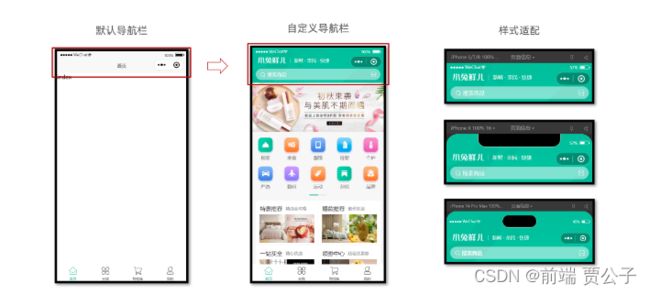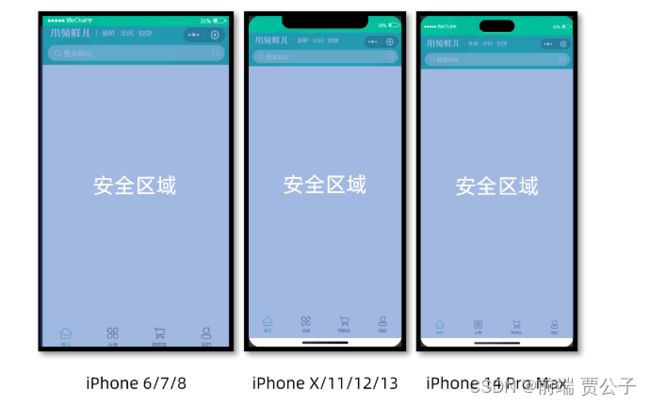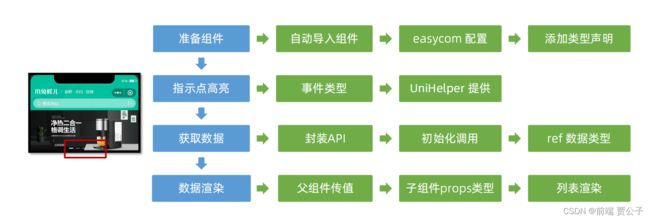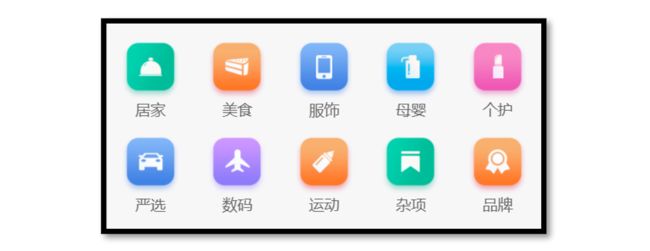uniapp 小兔鲜儿 - 首页模块(1)
目录
自定义导航栏
静态结构
安全区域
通用轮播组件
静态结构
自动导入全局组件
全局组件类型声明
.d.ts文件
注册组件
@vue/runtime-core
首页 – 轮播图指示点
首页 – 获取轮播图数据
首页 – 轮播图数据类型并渲染
首页 – 轮播图总结
首页分类
首页 – 前台分类组件
首页 – 获取前台分类数据
首页 – 前台分类数据类型并渲染
自定义导航栏
参考效果:自定义导航栏的样式需要适配不同的机型。
操作步骤
-
准备组件
-
隐藏默认导航栏,修改文字颜色
-
样式适配 -> 安全区域
静态结构
新建业务组件:src/pages/index/componets/CustomNavbar.vue
新鲜 · 亲民 · 快捷
搜索商品
安全区域
不同手机的安全区域不同,适配安全区域能防止页面重要内容被遮挡。
可通过 uni.getSystemInfoSync() 获取屏幕边界到安全区的距离。
核心代码参考
自定义导航配置
// src/pages.json
{
"path": "pages/index/index",
"style": {
"navigationStyle": "custom", // 隐藏默认导航
"navigationBarTextStyle": "white",
"navigationBarTitleText": "首页"
}
}组件安全区适配
通用轮播组件
参考效果
小兔鲜儿项目中总共有两处广告位,分别位于【首页】和【商品分类页】。
轮播图组件需要在首页和分类页使用,需要封装成通用组件。
静态结构
首页广告布局为独立的组件 XtxSwiper ,位于的 src/components 目录中。
该组件定义了 list 属性接收外部传入的数据,内部通过小程序内置组件 swiper 展示首页广告的数据。
轮播图组件
静态结构:src/components/XtxSwiper.vue
自动导入全局组件
参考配置
{
// 组件自动引入规则
"easycom": {
// 是否开启自动扫描 @/components/$1/$1.vue 组件
"autoscan": true,
// 以正则方式自定义组件匹配规则
"custom": {
// uni-ui 规则如下配置
"^uni-(.*)": "@dcloudio/uni-ui/lib/uni-$1/uni-$1.vue",
// 以 Xtx 开头的组件,在 components 目录中查找
"^Xtx(.*)": "@/components/Xtx$1.vue"
}
}
}全局组件类型声明
.d.ts文件
在 TypeScript 中,.d.ts 文件是用来描述 JavaScript 模块或库的声明文件。这些声明文件用于提供类型信息,使得 TypeScript 在引用外部 JavaScript 库时可以获得类型检查和代码提示的支持。
声明文件通常以.d.ts为扩展名,并与相应的 JavaScript 文件相对应。它们用于描述库的类型定义和类型推断规则,以及函数、类、接口和变量的声明。
下面是一个用于声明一个简单 JavaScript 模块的 .d.ts 文件的示例:
// myModule.d.ts
// 导出一个函数的声明
export function myFunction(param: string): void;
// 导出一个类的声明
export class MyClass {
constructor(name: string);
sayHello(): void;
}
// 导出一个接口的声明
export interface MyInterface {
id: number;
name: string;
}
// 导出一个变量的声明
export const myVariable: number;
在上述例子中,我们声明了一个名为myModule的模块,其中包含一个导出函数myFunction,一个导出类MyClass,一个导出接口MyInterface和一个导出变量myVariable。
这个声明文件可以被其他 TypeScript 文件引入和使用:
// index.ts
import { myFunction, MyClass, MyInterface, myVariable } from './myModule';
myFunction('Hello'); // 类型检查
const instance = new MyClass('John'); // 类型检查
instance.sayHello(); // 类型检查
const obj: MyInterface = { id: 1, name: 'John' }; // 类型检查
console.log(myVariable); // 类型检查
通过引入声明文件,TypeScript 可以提供类型检查和自动补全的功能,从而帮助开发者在编写代码过程中减少错误,并提高代码的可维护性。
总结来说,.d.ts 文件是用来提供 JavaScript 模块或库的类型信息的。它们描述了函数、类、接口和变量的声明,使得 TypeScript 能够对外部 JavaScript 代码进行类型检查和代码提示。
注册组件
Volor 插件说明:Vue Language Tools![]() https://github.com/vuejs/language-tools
https://github.com/vuejs/language-tools
这段代码是一个声明模块的代码,它引入了一个名为XtxSwiper的Vue组件,并将其注册为全局组件。具体来说,代码的功能如下:
-
import XtxSwiper from './XtxSwiper.vue':这行代码引入了一个名为XtxSwiper的Vue组件,该组件可能是一个图片轮播组件或其他类型的组件。 -
declare module '@vue/runtime-core':这行代码声明了一个模块,并指定其名称为"@vue/runtime-core"。 -
{ export interface GlobalComponents { XtxSwiper: typeof XtxSwiper } }:这行代码在声明的模块中定义了一个接口GlobalComponents,该接口包含了一个XtxSwiper属性。这个XtxSwiper属性的类型是typeof XtxSwiper,表示它与之前引入的XtxSwiper组件具有相同的类型。
// src/types/components.d.ts
import XtxSwiper from './XtxSwiper.vue’
declare module '@vue/runtime-core' {
export interface GlobalComponents {
XtxSwiper: typeof XtxSwiper
}
} @vue/runtime-core
@vue/runtime-core 是 Vue.js 框架的运行时核心库。在 Vue.js 中,有两个主要的库:编译时(compiler)和运行时(runtime)。编译时负责将模板转换为渲染函数,而运行时则负责实际的渲染、组件管理等。
@vue/runtime-core 是 Vue 3 中运行时的核心部分,它包含了实际执行渲染、响应式系统、虚拟 DOM 和其他运行时相关的功能。Vue 3 使用了模块化的方式来组织这些功能,因此你会在代码中看到像 @vue/runtime-core 这样的模块引用。
在你的代码示例中,通过声明模块 @vue/runtime-core,你可以扩展 Vue 运行时的全局类型和功能,以便让类型检查器和编辑器能够正确地理解和处理这些扩展。具体到你的代码,它在全局注册了一个名为 XtxSwiper 的组件,使得在整个应用中都可以直接使用这个组件,而不需要在每个单独的组件中都进行导入和注册。
首页 – 轮播图指示点
- UniHelper 提供事件类型,文档说明
- ?(可选链) 允许前面表达式为空值
- !(非空断言) 主观上排除掉空值情况
const activeIndex = ref(0);
const onChange: UniHelper.SwiperOnChange = (ev) => {
// ! 非空断言,主观上排除掉空值情况
activeIndex.value = ev.detail!.current;
};首页 – 获取轮播图数据
export const getHomeBannerAPI = (distributionSite = 1) => {
return http({
method: 'GET',
url: '/home/banner',
data: {
distributionSite,
},
})
} import { onLoad } from '@dcloudio/uni-app'
import { getHomeBannerAPI } from '@/services/home'
import type { BannerItem } from '@/types/home'
import { ref } from 'vue'
const bannerList = ref([])
const getHomeBannerData = async () => {
const res = await getHomeBannerAPI()
console.log(res)
bannerList.value = res.result
console.log(bannerList.value)
}
onLoad(() => {
getHomeBannerData()
}) 首页 – 轮播图数据类型并渲染
/** 首页-广告区域数据类型 */
export type BannerItem = {
/** 跳转链接 */
hrefUrl: string
/** id */
id: string
/** 图片链接 */
imgUrl: string
/** 跳转类型 */
type: number
}
3. 渲染轮播图数据
defineProps<{
list: BannerItem[]
}>()
首页 – 轮播图总结
首页分类
首页 – 前台分类组件
准备工作
- 准备组件,只有首页使用
前台类目布局为独立的组件 CategoryPanel属于首页的业务组件,存放到首页的 components 目录中。
居家
- 导入并使用组件
import CategoryPanel from "./componets/CategoryPanel.vue";
- 设置首页底色为
#F7F7F7
首页 – 获取前台分类数据
1. 封装获取前台分类数据API
/**
* 首页-前台分类-小程序
*/
export const getHomeCategoryAPI = () => {
return http({
method: 'GET',
url: '/home/category/mutli',
})
}
2. 页面初始化调用API
import type { CategoryItem } from "@/types/home";
import { getHomeCategoryAPI } from "@/services/home";
import { onLoad } from "@dcloudio/uni-app";
import { ref } from "vue";
const categoryList = ref([]);
const getHomeCategoryData = async () => {
const res = await getHomeCategoryAPI();
categoryList.value = res.result;
console.log(res);
};
onLoad(() => {
getHomeCategoryData();
}); 首页 – 前台分类数据类型并渲染
1. 定义前台分类数据类型
export type CategoryItem = {
/** 图标路径 */
icon: string
/** id */
id: string
/** 分类名称 */
name: string
}
2. 指定类型并传值给子组件
import type { CategoryItem } from "@/types/home";
defineProps<{
list: CategoryItem[];
}>();
3. 渲染前台分类数据
{{ item.name }}







